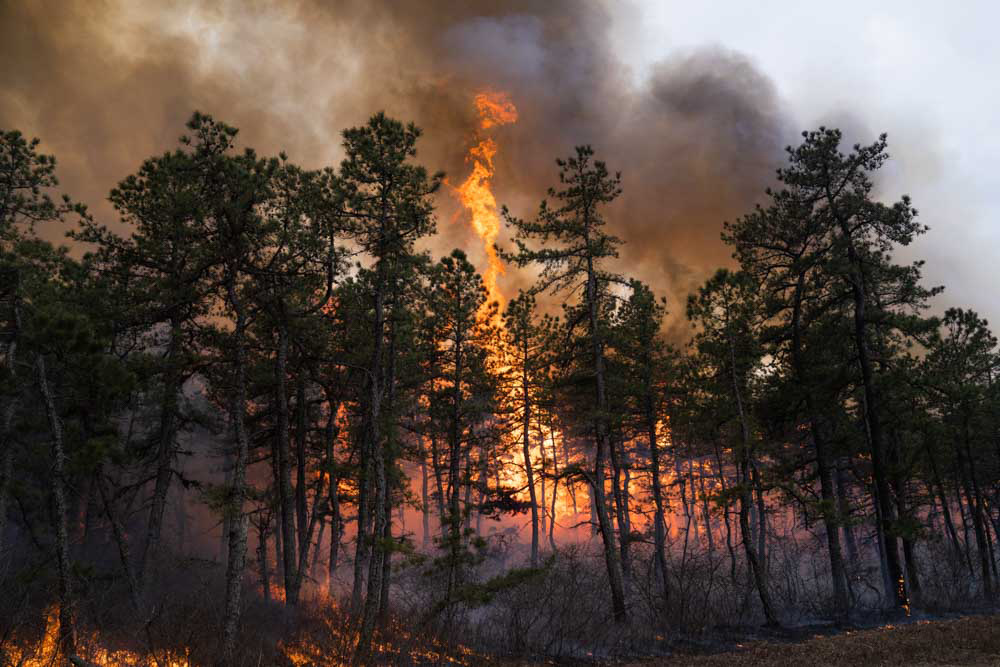Weather
By Dan Skeldon
Spring officially arrived last weekend, and with it comes the gradually warmer and longer days that serve as the prelude to summer. Meteorologically speaking, late March through late May is one of the quieter times of the year in South Jersey weather-wise. We’re past the prime coastal storm season, and our severe storm season doesn’t usually activate until the heat and humidity regularly visit our region, usually starting in June. We don’t have to worry about the tropics until then either, as hurricane season doesn’t begin until June 1st each year.
In fact, the biggest concern in South Jersey over the next few months is dry weather. Well, it’s the combination of prolonged dry weather, gusty winds, and low relative humidity, which when combined just right is the perfect recipe for forest fires. And the South Jersey Pinelands, while a local ecological and natural treasure, can offer prime breeding ground for occasionally intense fires, given a perfect storm of conditions and ingredients. While our fire season thankfully pales in comparison to those out west in terms of acreage, intensity, and longevity, South Jersey forest fires can prove destructive to property and harmful to both local residents and those fighting any fires.
Before moving to South Jersey in 2002, I actually knew little about forest fires. How they started. How they spread. How to effectively fight them. How to forecast for them. And I certainly didn’t think New Jersey had a legitimate fire season, instead thinking such a thing was limited to the more notorious areas out in the Western United States. Furthermore, I didn’t have a full appreciation for the critical role weather conditions played in fighting a fire. It’s not something they taught in college. But all that changed after spending a few fire seasons in South Jersey, and more specifically, spending a weekend near the front lines of a fire.
Being on location during a large Ocean County wildfire back around 2010, providing a “nowcast” of precise winds, temperatures, and relative humidity levels, was a humbling and eye-opening experience for a young meteorologist. First and foremost, it gave me a new appreciation of what firefighters deal with. Personally, it reinforced the importance of the science I love, meteorology, and how vital an accurate, localized forecast can be in a crucial situation. Similar to tracking a tornado that is on the ground and trying to warn those that may be in its future path, forest fire forecasting is just as pivotal.
A mere shift in the wind direction, from southwest to southeast for instance, can entirely change the trajectory of the fire. And we of course all know that wind shifts are a common occurrence in South Jersey, none more common than the sea-breeze. Sea-breezes do lead to shifting winds, but also bring in more humid ocean air, which can help reduce the fuel for a fire that is more responsive to dry air with low relative humidity. Another factor both firefighters and forecasters have to consider is that the more intense fires can actually make their own weather, further complicating things.
Forecasting higher fire danger is something we have much success with, compared to the complexities of nowcasting a fire once it has developed. The National Weather Service will issue Fire Weather Watches when conditions have the potential to be favorable for rapid fire spread if a brush fire were to form. Red Flag Warnings are issued when those conditions are likely to occur, namely strong winds, dry fuels, and low relative humidity levels. And considering most forest fires are started by humans, we should all use extra caution on those handful of days each spring and sometimes again the fall when our fire danger is elevated. A single cigarette butt or spark from an automobile is all it takes to trigger a wildfire that could go on to burn thousands of acres.
With that extra caution in mind while outdoors this spring, especially on those high fire danger days, be sure to enjoy this normally quieter time of the year weather-wise. Fire season will continue through “green up”, when trees and other vegetation turn green and add moisture to the ecosystem, reducing the otherwise dry fuels that are present before green up.
Meteorologist Dan Skeldon has a degree in meteorology from Cornell University. He has forecasted the weather in South Jersey for the last 18 years, first on the former television station NBC40 and then on Longport Media radio. Dan has earned the American Meteorological Society Seal of Approval for Broadcast Meteorologists, and now does television broadcasts on WFMZ-TV in Pennsylvania’s Lehigh Valley.






